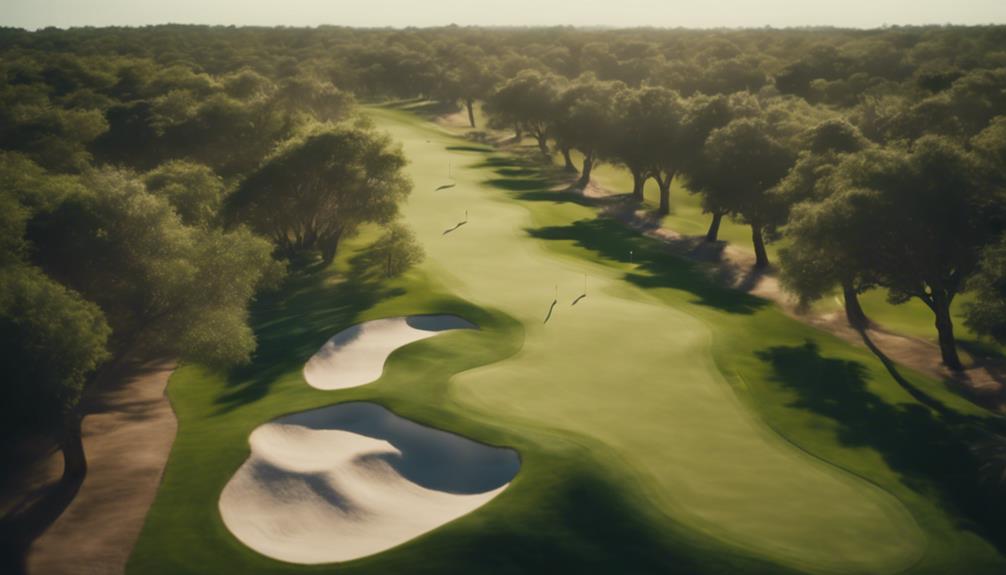- 7 Top Flite Golf Clubs XL for Improved Performance - September 28, 2024
- Top Flite Golf Clubs: Top 5 Reasons to Choose Them - September 28, 2024
- Top 3 Golf Club Fitters for a Perfect Swing - September 28, 2024
You'll likely spend between $1 million and $5 million to build a professional-level golf course, with the final cost depending on factors like location, land type, course complexity, and architect expertise. Even 9-hole courses can cost around $500,000 to $1 million. To optimize costs, consider prioritizing land use, efficient routing, and natural feature incorporation. Labor, equipment, and maintenance expenses also add up quickly. Understanding these cost factors is essential for budget management. As you explore the intricacies of golf course construction, you'll uncover more opportunities to strike a balance between cost and quality.
Key Takeaways
- The cost of building a golf course ranges from $1 million to $5 million, depending on factors like location, materials, and luxury amenities.
- A 9-hole golf course is a cost-effective alternative, with prices ranging from $500,000 to $1 million, and a single hole construction cost of around $10,000.
- Initial construction costs and ongoing maintenance expenses, including labor, equipment, and overhead, add up quickly and require careful budgeting.
- Geographic location significantly impacts construction costs, with urban areas and high-cost regions increasing expenses, while rural locations offer cost-saving opportunities.
- Balancing cost and quality is crucial, with strategic decisions on spending and prioritization necessary to ensure a strong return on investment.
Factors Affecting Construction Costs
When constructing a golf course, several key factors heavily influence construction costs, including the location, land type, course complexity, and architect's expertise, which can result in a wide range of expenditures. As you start on this project, it's vital to grasp how these factors impact your budget.
The type of golf course you're developing, whether it's private, resort, or public, also plays a significant role in determining construction expenses. Additionally, you'll need to take into account costs like land acquisition, design fees, construction materials, irrigation systems, and clubhouse amenities, which can add up quickly.
Collaborating with a golf course architect is essential in understanding the financial implications of your design choices. They can assist you in optimizing resources, managing costs, and making informed decisions about your project. By consulting with an expert, you'll gain a deeper understanding of how your choices will impact your bottom line.
With their guidance, you can make strategic decisions to minimize expenses without compromising the quality of your golf course. By taking these factors into account and collaborating with a golf course architect, you'll be better equipped to manage construction costs and bring your project to life within budget.
Professional Level Golf Course Costs
Constructing a professional-level golf course can incur expenses ranging from $1 million to $5 million, contingent on factors like luxury level, location, materials, and layout.
You'll need to contemplate the level of luxury you're aiming for, as high-end courses with premium amenities can significantly raise the cost of construction. The location also plays a pivotal role, as courses built in urban areas or those that necessitate extensive landscaping can be more costly.
The cost of constructing a professional golf course can vary widely, with some of the most costly courses reaching prices in the hundreds of millions. For instance, Trump Golf Links in The Bronx incurred approximately $269 million to build, while Trump National Golf Club in Los Angeles and Liberty National Golf Course in Jersey City required $264 million and $250 million, respectively, for construction.
Nonetheless, on the lower end, you can still achieve a high-quality course for a lower expense. Understanding the factors that impact the cost of construction will assist you in making well-informed decisions and staying within your budget.
Building a 9-Hole Golf Course

Constructing a 9-hole golf course can be a cost-effective alternative to building an 18-hole course, with prices ranging from $500,000 to $1 million, depending on the level of amenities and course size. You'll need to take into account factors like location, course design, and materials to determine the final cost.
Since building a single hole can cost around $10,000, a 9-hole course can be a more budget-friendly option for smaller projects.
If you're looking to save even more, you could opt for DIY construction, which can cater to family activities or events. However, keep in mind that the overall value and costs of constructing a 9-hole golf course depend on various factors such as design choices, materials, and maintenance needs.
A well-planned course design can help minimize costs while ensuring a high-quality playing experience.
When planning your 9-hole course, take into account the type of terrain, water features, and obstacles you want to incorporate. A thoughtful course design won't only enhance the gameplay but also reduce maintenance costs in the long run.
Budget Golf Course Construction
You can opt for budget golf course construction, which prioritizes cost-effectiveness while still providing an enjoyable golfing experience, to create a more accessible and affordable option for players. Building a golf course on a budget doesn't mean sacrificing quality; it's about making smart decisions to reduce costs without compromising the game. For instance, building a single hole can cost around $10,000, making it a more affordable option compared to full courses.
DIY construction can also provide significant savings and potential for family activities or events.
When building a 9-hole budget golf course, you can expect to pay between $500,000 to $1 million, depending on amenities, location, and course size. Factors such as course size, amenities, and location play an essential role in determining the costs and overall value of budget golf course construction.
Understanding Golf Course Expenses

Developing a thorough understanding of the various expenses involved in golf course construction is essential for creating a financially viable project, as the overall cost can add up quickly. When building a golf course, you'll need to take into account not only the initial construction costs but also the expenses associated with maintaining the course over time.
This includes labor costs, equipment expenses, and materials for upkeep. You'll also need to factor in real estate costs, such as land acquisition and property taxes, as well as overhead expenses like insurance and administrative fees.
When building and maintaining a golf course, it's important to have a detailed understanding of all these associated costs. This will enable you to create a thorough budget and make informed decisions about where to allocate your resources.
Ongoing Operational Costs
As you consider the ongoing operational costs of your golf course, you'll need to account for monthly overhead expenses, which can include everything from administrative salaries to insurance premiums.
You'll also need to factor in utility and labor costs, which can fluctuate depending on the course's size, amenities, and location.
Monthly Overhead Expenses
Monthly overhead costs, which can range from $50,000 to over $200,000, are a significant component of a golf course's operational budget, encompassing essential expenditures necessary to maintain the facility's daily operations. As the owner of a golf course, you'll need to take into account these ongoing costs to guarantee the smooth functioning of your business.
| Expense Category | Estimated Monthly Cost |
|---|---|
| Maintenance | $10,000 – $30,000 |
| Insurance | $5,000 – $10,000 |
| Office Expenses | $2,000 – $5,000 |
| Marketing and Advertising | $5,000 – $10,000 |
| Miscellaneous (repairs, etc.) | $5,000 – $10,000 |
These expenses can vary depending on the size, amenities, and location of your golf course. It's essential to manage these monthly overhead expenses effectively to ensure financial sustainability and long-term success. By understanding the breakdown of these costs, you can make informed decisions about budget allocation and revenue generation. Remember, green fees and tournament entry fees are vital revenue streams that help offset these monthly overhead costs.
Utility and Labor Costs
You'll need to allocate a significant portion of your operational budget to cover utility and labor costs, which can collectively total hundreds of thousands of dollars annually, depending on the size and amenities of your golf course.
Utility costs, which can range from $30,000 to $50,000 per year, are a significant ongoing expense. However, labor costs are even more substantial, typically making up 50-70% of your operational budget.
Maintenance labor costs alone can range from $500,000 to $1.5 million yearly, covering salaries, benefits, training, and equipment maintenance for staff.
Additionally, irrigation system maintenance costs can add up to $20,000 to $50,000 per year, covering water usage, system repairs, and upgrades.
To guarantee the smooth functioning and maintenance of your golf course, it's essential to properly budget for these ongoing operational costs. By allocating sufficient funds, you'll be able to maintain your course's quality and reputation, ultimately driving revenue and growth.
Cost-Saving Design Strategies

As you explore cost-saving design strategies, you'll find that optimizing land use is key to reducing construction costs.
By reducing bunker counts and incorporating efficient irrigation systems, you can further minimize expenses without compromising the course's overall aesthetic and playability.
Optimizing Land Use
By applying cost-saving design strategies, golf course architects can maximize land utilization and reduce construction expenses through efficient routing and hole configurations that creatively incorporate natural features.
You can optimize land use by strategically placing bunkers, hazards, and greens to create an engaging layout while minimizing land and construction expenses.
Additionally, consider building multi-purpose facilities like clubhouses and practice areas to maximize land utilization and cost-effectiveness.
When designing the course, you should utilize natural features like slopes and water bodies creatively to minimize earth-moving expenses. Incorporating native vegetation and landscaping can also lower maintenance costs and enhance sustainability.
By doing so, you can allocate more resources to other essential aspects of the project, such as irrigation systems and course amenities.
Reducing Bunker Counts
Reducing the number of bunkers on a golf course can be an extremely effective cost-saving design strategy, allowing architects to allocate resources more efficiently while maintaining playability and aesthetics. By doing so, you can lower construction and maintenance costs to a great extent.
Removing or consolidating bunkers means less labor, material, and maintenance costs associated with bunker upkeep. This strategic approach enables you to minimize bunkers while maintaining playability, ultimately enhancing the overall design and saving on construction expenses. Fewer bunkers also translate to reduced sand and drainage costs during the building phase.
As a golf facility developer, you should consider implementing a thoughtful bunker design approach to achieve cost-effective golf course construction and long-term maintenance. By adopting this strategy, you can redirect resources to other essential areas of your golf facility, such as course landscaping or amenities.
Efficient Irrigation Systems
You can greatly lessen water consumption and maintenance costs by incorporating efficient irrigation systems into your golf course design. By investing in modern irrigation technology, such as smart controllers and drip irrigation, you can markedly reduce water usage and expenses.
A properly designed irrigation system ensures that water is distributed evenly across the course, promoting healthy turf growth while minimizing waste. Implementing rain sensors and soil moisture sensors can further optimize irrigation schedules and prevent overwatering, leading to cost savings.
Additionally, choosing drought-resistant grass species and turf varieties can contribute to reducing irrigation requirements and overall water expenses for golf course construction. When designing your irrigation system, consider the specific needs of your course, including climate, soil type, and turf species.
Geographic Location Impacts
One key factor that greatly influences the cost of constructing a golf course is the geographic area, which can either increase or decrease construction expenses depending on the region's features. As you plan your golf course project, it's crucial to take into account the impact of geographic location on your budget.
Building a golf course in urban areas or high-cost regions like New York City can result in significantly higher construction expenses compared to rural or less expensive locations. On the other hand, rural locations with ample land and lower labor costs can offer cost-saving opportunities, making them more financially viable for developers.
Moreover, locations with severe climates or challenging terrain may necessitate additional investments in engineering solutions, irrigation systems, and land preparation, affecting the overall construction costs. Your geographic location can directly influence the overall budget for constructing a golf course, underscoring the importance of thorough cost analysis and site selection in the planning process.
Balancing Cost and Quality

Establishing a delicate balance between cost and quality is crucial to creating a golf course that aligns with your vision while staying within budget, as excessive spending on luxurious features can quickly deplete resources. You need to prioritize your spending to guarantee a strong return on investment.
| Feature | Cost | Impact on Quality |
|---|---|---|
| High-end irrigation system | $200,000 | High |
| Average-quality clubhouse | $500,000 | Medium |
| Basic landscaping | $100,000 | Low |
Frequently Asked Questions
How Much Money Can You Make Owning a Golf Course?
You can generate significant revenue owning a golf course, with annual earnings ranging from millions to modest profits, depending on your course's quality, location, and marketing savvy, which directly impact your revenue potential.
How Many Acres Do You Need to Build a Golf Hole?
When planning a golf course, you'll need to contemplate the course layout, as it affects the required land area; typically, a hole takes 1-1.5 acres, but this can vary depending on terrain and design elements.
How Many Years Does It Take to Build a Golf Course?
You'll spend around 1-2 years building a golf course, depending on its size and complexity, with the construction timeline typically broken down into 6-12 months of planning and 9-18 months of actual construction.
How Much Does It Cost to Build a Par 3 Hole?
You'll spend around $100,000 to $200,000 building a single Par 3 hole, where the design process greatly impacts costs, with factors like land preparation, construction materials, and complexity driving up expenses.
Conclusion
As you weigh the costs of building a golf course, remember that every detail counts.
Did you know that according to the National Golf Foundation, the average cost of building a golf course is around $5 million per 18 holes?
This staggering figure underscores the importance of balancing cost and quality.
By understanding the factors that drive construction costs and implementing cost-saving design strategies, you can create a world-class golf course that meets your budget and exceeds player expectations.




